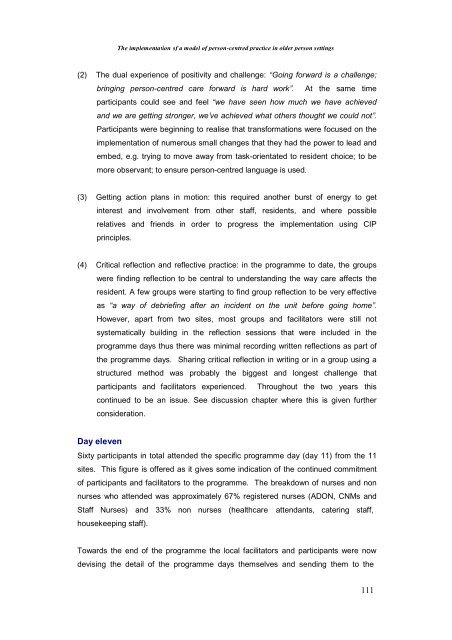The Implementation of a Model of Person-Centred Practice In Older ...
The Implementation of a Model of Person-Centred Practice In Older ...
The Implementation of a Model of Person-Centred Practice In Older ...
You also want an ePaper? Increase the reach of your titles
YUMPU automatically turns print PDFs into web optimized ePapers that Google loves.
<strong>The</strong> implementation <strong>of</strong> a model <strong>of</strong> person-centred practice in older person settings<br />
(2) <strong>The</strong> dual experience <strong>of</strong> positivity and challenge: “Going forward is a challenge;<br />
bringing person-centred care forward is hard work”. At the same time<br />
participants could see and feel “we have seen how much we have achieved<br />
and we are getting stronger, we’ve achieved what others thought we could not”.<br />
Participants were beginning to realise that transformations were focused on the<br />
implementation <strong>of</strong> numerous small changes that they had the power to lead and<br />
embed, e.g. trying to move away from task-orientated to resident choice; to be<br />
more observant; to ensure person-centred language is used.<br />
(3) Getting action plans in motion: this required another burst <strong>of</strong> energy to get<br />
interest and involvement from other staff, residents, and where possible<br />
relatives and friends in order to progress the implementation using CIP<br />
principles.<br />
(4) Critical reflection and reflective practice: in the programme to date, the groups<br />
were finding reflection to be central to understanding the way care affects the<br />
resident. A few groups were starting to find group reflection to be very effective<br />
as “a way <strong>of</strong> debriefing after an incident on the unit before going home”.<br />
However, apart from two sites, most groups and facilitators were still not<br />
systematically building in the reflection sessions that were included in the<br />
programme days thus there was minimal recording written reflections as part <strong>of</strong><br />
the programme days. Sharing critical reflection in writing or in a group using a<br />
structured method was probably the biggest and longest challenge that<br />
participants and facilitators experienced. Throughout the two years this<br />
continued to be an issue. See discussion chapter where this is given further<br />
consideration.<br />
Day eleven<br />
Sixty participants in total attended the specific programme day (day 11) from the 11<br />
sites. This figure is <strong>of</strong>fered as it gives some indication <strong>of</strong> the continued commitment<br />
<strong>of</strong> participants and facilitators to the programme. <strong>The</strong> breakdown <strong>of</strong> nurses and non<br />
nurses who attended was approximately 67% registered nurses (ADON, CNMs and<br />
Staff Nurses) and 33% non nurses (healthcare attendants, catering staff,<br />
housekeeping staff).<br />
Towards the end <strong>of</strong> the programme the local facilitators and participants were now<br />
devising the detail <strong>of</strong> the programme days themselves and sending them to the<br />
111
















